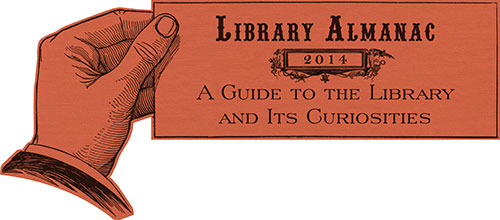Just as farmers consult almanacs for information about the weather and guides to planting crops, members of the Emory community and new students will have an “almanac” to consult for information about the library and guides to using its collections and services. “Library Almanac 2014: A Guide to the Library and its Curiosities,” is an exhibit that will open Aug. 25 on level 2 of the Woodruff Library just as students and faculty return to campus to begin the fall semester.
 Have you ever tried to guess how many books arrive at the library each year? How many languages the subject librarians speak? How many countries are the destinations for books loaned by the library? The answers can be found in the library almanac. Have you ever wondered how many staff members make things happen in the library? Whom to consult when you start a research project? Why are there Tyrannicides in the Matheson Reading Room? The library almanac exhibit can be your source for this information, too.
Have you ever tried to guess how many books arrive at the library each year? How many languages the subject librarians speak? How many countries are the destinations for books loaned by the library? The answers can be found in the library almanac. Have you ever wondered how many staff members make things happen in the library? Whom to consult when you start a research project? Why are there Tyrannicides in the Matheson Reading Room? The library almanac exhibit can be your source for this information, too.
Covering topics ranging from services to collections and from people to spaces, the library almanac will introduce the viewer to important, interesting and even entertaining information about the library. The annual pamphlet published in 18th-century America, Poor Richard’s Almanack, included practical household hints, wit and wisdom, along with weather forecasts, puzzles and amusements. Taking a cue from author Benjamin Franklin, the library almanac exhibit presents practical library hints for finding help using the library, amusing information like the descriptions of the largest and smallest books in the library, and wise advice about how borrow a book that is not in the library’s collection.
And just so you won’t be left wondering, more than 42,000 books arrived at the library last year; the subject librarians speak at least 17 languages; the library sent books to 12 different countries in a single month this summer; nearly 350 individuals work in the library; help using the library can be found at the library service desk and on the library website (including a new feature entitled “Library Simplified”); and the Tyrannicides (plaster casts of a Roman marble copy of a Greek bronze dating from ca. 477 BC) are on loan from Emory’s Carlos Museum to support teaching and research in art history and ancient and Mediterranean studies.
